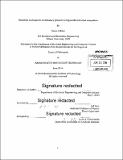Exploring multispecies evolutionary dynamics using model microbial ecosystems
Author(s)
Celiker, Hasan
DownloadFull printable version (8.609Mb)
Other Contributors
Massachusetts Institute of Technology. Department of Electrical Engineering and Computer Science.
Advisor
Jeff Gore.
Terms of use
Metadata
Show full item recordAbstract
Experiments to date probing adaptive evolution have predominantly focused on studying a single species or a pair of species in isolation. In nature, on the other hand, species evolve within complex communities, interacting and competing with many other species. We developed experimental microbial ecosystems with which we can start to answer some of the fundamental questions regarding evolution in complex ecosystems. We first tested how the evolution of cooperation within a species can be affected by the presence of competitor species in an ecosystem. To achieve this, we used sucrose metabolism of budding yeast, Saccharomyces cerevisiae, as a model cooperative system that is subject to social parasitism by cheater strategies. We found that when co-cultured with a bacterial competitor, Escherichia coli, the frequency of cooperator phenotypes in yeast populations increases dramatically as compared to isolated yeast populations. These results indicate that a thorough understanding of species interactions is crucial for explaining the maintenance and evolution of cooperation in nature. Next, we wanted to explore the question of whether evolution in a multispecies community is deterministic or random. We let many replicates of a multispecies laboratory bacterial ecosystem evolve in parallel for hundreds of generations. We found that after evolution, relative abundances of individual species varied greatly across the evolved ecosystems and that the final profile of species frequencies within replicates clustered into several distinct types, as opposed to being randomly dispersed across the frequency space or converging fully. These results suggest that community structure evolution has a tendency to follow one of only a few distinct paths.
Description
Thesis: Ph. D., Massachusetts Institute of Technology, Department of Electrical Engineering and Computer Science, 2014. 76 Cataloged from PDF version of thesis. Includes bibliographical references (pages 79-85).
Date issued
2014Department
Massachusetts Institute of Technology. Department of Electrical Engineering and Computer SciencePublisher
Massachusetts Institute of Technology
Keywords
Electrical Engineering and Computer Science.